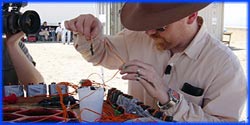


Premier Date: June 12, 2013
busted
For a small-scale test, Adam built a 1/6 scale model of the car out of polycarbonate. To simulate the overweight people, he made two cylindrical leather pouches filled with water balloons. When hit from the side with a swinging tree stump, a mini-Buster seated alone in the backseat of the model car sustained a lethal g-force of 150 g, but only 30 g (survivable) when placed between the pouches, giving the myth some plausibility.
For the full-scale experiment, Adam and Jamie modified a large dump truck called “the Beast” (previously seen in the final JATO Rocket Car revisit) with a large steel plate welded to the front. Two simulated 350 lb (160 kg) men were sculpted from foam, covered rubber, and filled with water just before the tests.
For the control test, a simulated cadaver with a full musculoskeletal system sat alone in the back seat of a car of the same make and model as in the movie. Beast was driven at 50 miles per hour (80 km/h) into the side of the car, producing a violent crash. X-rays of the simulated cadaver revealed that it sustained multiple devastating fractures, and an orthopedic surgeon declared him “very, very dead.” Accelerometers confirmed this by measuring g-forces in the range of 500-600 g.
After a new simulated cadaver was placed between the simulated overweight people, the crash was repeated. This time, the simulated cadaver was fully decapitated and the accelerometers maxed out at 800 g, making him “even more dead.” Adam and Jamie were surprised and Jamie speculated that because water is incompressible and humans are mostly water, the human body is ineffective as a cushion.
busted
The Build Team began by individually testing some hypermiling techniques that the show had net yet examined: driving at a slower speed on the highway, accelerating and braking in as slowly and smoothly as possible, and turning off the engine when stopped at a red light. All of the individual tests showed an increase in fuel efficiency of about 30% compared to the standard techniques.
Next, they combined all of hypermiling techniques above plus other ones, including: leaving the air conditioning off, over-inflating tires, removing one of the side mirrors, applying an aerodynamic skin, and legally drafting if possible. Kari and Grant drove a new vehicle while Tory drove an older vehicle with 75,000 miles (121,000 km) on the odometer. They mapped out a course on active roads with a variety of driving conditions. With 3 gallons of gas in the tanks, each car was first driven normally and without modifications. Kari and Grant were able to drive 64 miles (103 km) before running empty and Tory drove 78 miles (126 km). When employing all of the hypermiling techniques, Kari and Grant improve their mileage by 40% and Tory improved his by 70%. The myth was declared busted because they could not double the mileage, but the Build Team noted that hypermiling was quite effective nonetheless.
Previous: Episode 202: Motorcycle Water Ski